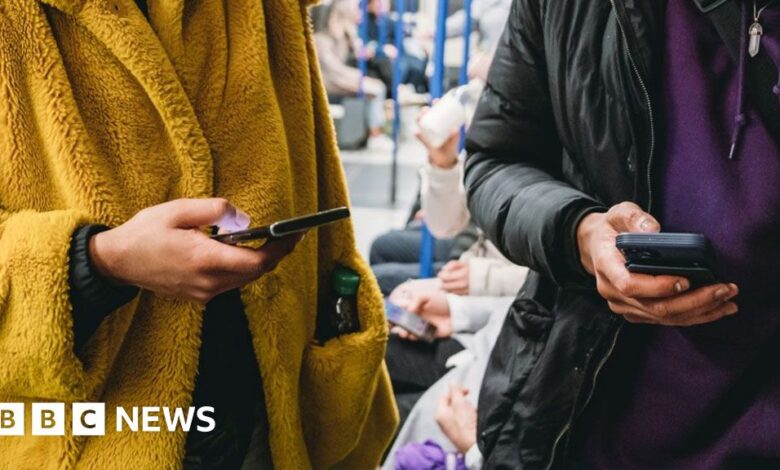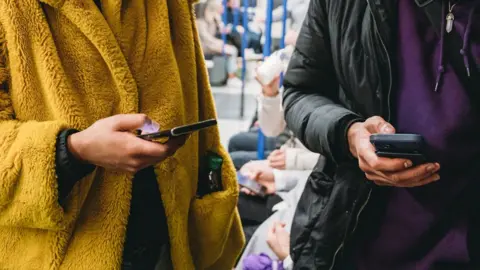Phone companies to be asked to help tackle rise in snatch thefts

2024-09-03 13:00:46
 Getty Images
Getty ImagesPhone companies are to be called into the Home Office to discuss measures to tackle crime after snatch thefts more than doubled in England and Wales over the last year.
Government figures indicate that, in the year to March, there were an estimated 78,000 thefts from the person – defined as items such as phones, bags and wallets being taken without force being used or threatened.
The figure for the previous year was 31,000.
Policing Minister Dame Diana Johnson said the government wanted manufacturers to ensure that any stolen phone could be permanently disabled to prevent it being sold second-hand.
Police chiefs will also be tasked with gathering more intelligence on who is stealing phones and where stolen devices end up.
A growing demand for second-hand phones, both in the UK and abroad, is believed to be a major driver behind the recent rise in thefts, the government said.
The Home Office is to host a summit at which tech companies and phone manufacturers will be asked to consider innovations that could help stop phones being traded illegally.
The government said it hoped to build on anti-theft features already introduced to smartphones.
Dame Diana said the government hoped to “break the business model” of the people organising the thefts.
“Phone companies must ensure that any stolen phones can be quickly, easily and permanently disabled, rather than re-registered for sale on the second-hand market, and we will be meeting them soon to discuss what further action is required to make that happen.”
At present, the prosecution rate for thefts from the person is very low.
Of the 78,000 such thefts the Crime Survey for England and Wales estimates occurred, only 0.8% resulted in a person being charged.
Almost 82% of investigations were closed without the police finding a suspect.
The efforts to tackle thefts will also include continued patrol surges in areas around the country most at risk of serious violence, including knifepoint robberies.
Commander Richard Smith of the National Police Chiefs’ Council said forces continued to” target those habitual criminals responsible for prolific offending”.
“However, we know that we cannot arrest our way out of this problem,” he said. “Manufacturers and the tech industry have an important role in reducing opportunities for criminals to benefit from the re-sale of stolen handsets.”
What to do if your phone is stolen
If your phone is stolen, you should contact the police and provide them your IMEI number – a 15-digit code unique to your device. It is also likely you will need this for an insurance claim.
It will be often be printed on the label on your device’s box, and most mobile providers can give you this information if you contact them.
You can also get this information ahead of any incidents by dialling *#06# on your phone, and many modern operating systems include this information in the settings menu.
You should tell your network provider, so they can cancel your Sim card and prevent thieves using your device.
While it may not be the first thing that comes to mind, you should also let your bank know – so thieves can’t use your mobile banking app. While this is less common, thieves sometimes target people by watching them login to online banking to glean their password, before stealing their device.
If you use two-factor authentication, you should remove your phone as a trusted device, and you might consider changing your email passwords too.
But it’s worth remembering that while this is all good practice to keep your data safe, in the vast majority of cases thieves are more interested in selling your device for profit on the second-hand market, rather than accessing your data.
Disabling devices
Both iPhone and Android devices have protections against theft.
On an iPhone you can use “Find My iPhone” to locate your device, providing you have turned it on before it was lost or stolen. You can then login to iCloud on a computer and track your phone. If it has been stolen, you can secure it and erase all your data.
Meanwhile Android has “Find My Device” which operates similarly, allowing you to lock your phone and erase your data remotely. Samsung users have a similar tool called “SmartThings Find”.
In these lost modes, Android and iPhone devices cannot be easily unlocked and used again, but thieves are always looking for new ways to bypass these protections.
Android 10+ users worldwide will soon receive a feature called Theft Detection Lock, which will use Google’s AI to figure out if your phone has been stolen – and lock the device down.
It does this by recognising how a phone moves and shakes if it’s been snatched out of somebody’s hand and speedily taken away.
Such a device can still be unlocked if someone knows the phone’s PIN or password, while if it triggers by accident it can be unlocked by fingerprint or face scan as normal.
Google is also rolling out an upgrade to how a phone is reset to factory settings, to make it so a device can only be set up again by using the device’s password.
The government wants phone companies to make sure that stolen devices cannot be resold on the second-hand market.
Network operators blacklist the IMEI of devices which are reported stolen, meaning they generally speaking cannot be resold in the UK.
Because of this, thieves will often send stolen devices overseas to be resold in other countries where the IMEI has not been blocked.
Stopping this would require some kind of truly permanent lock to make a device completely unusable for good after it’s reported stolen – presumably involving phone companies making it so a device cannot even be turned on once it’s reported stolen.





